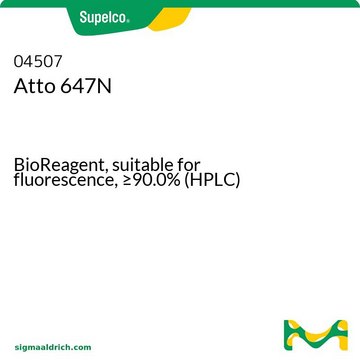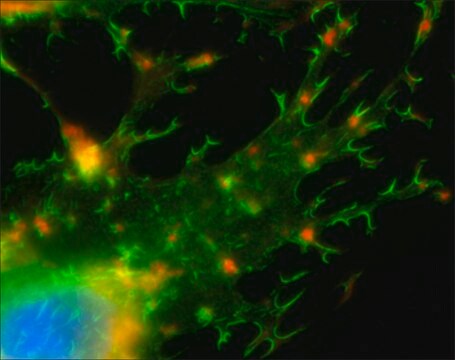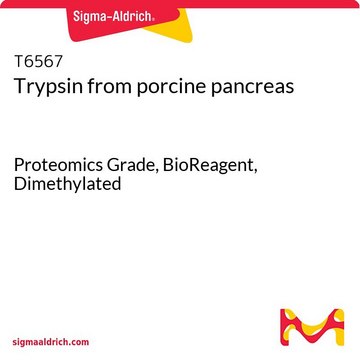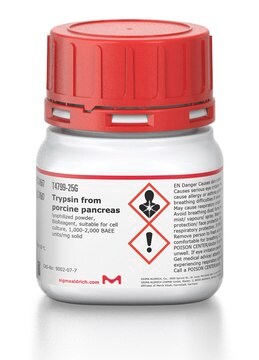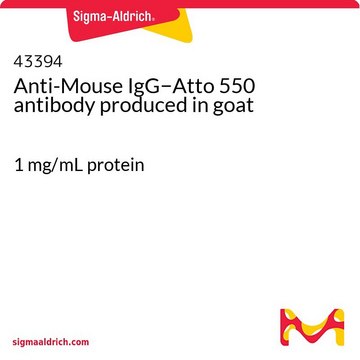65906
Phalloidin–Atto 647N
BioReagent, suitable for fluorescence, ≥80% (HPLC)
Sinônimo(s):
Atto 647N, Atto 647N-Phalloidin
Faça loginpara ver os preços organizacionais e de contrato
About This Item
Código UNSPSC:
12171501
NACRES:
NA.32
Produtos recomendados
linha de produto
BioReagent
Ensaio
≥80% (HPLC)
fabricante/nome comercial
ATTO-TEC GmbH
λ
in methanol
Absorção UV
λ: 640-646 nm Amax
adequação
suitable for fluorescence
método de detecção
fluorometric
temperatura de armazenamento
−20°C
Categorias relacionadas
Descrição geral
Phalloidin–Atto 647N is a new fluorescentlabel targeting the red spectral region. Atto 647N is a cationic dye, and postcoupling, it carries a net electrical charge of +1.Like most Atto labels, the absorption andfluorescence of Atto 647N are independent of pH between 2-11. Atto 647N issupplied in the form of a mixture containing two isomers having identicalfluorescence and absorption properties. Atto labels have rigid structures thatdo not show any cis-trans-isomerization.
Aplicação
Phalloidin–Atto 647Nis designed to be used for labelling DNA, RNA, or proteins. Fluorescentconjugates of phalloidin are used to label actin filaments for histologicalapplications. Some structural features of phalloidin are required for thebinding to actin.
Características e benefícios
Characteristic features of the Phalloidin Atto488 are:
- StrongAbsorption.
- HighFluorescence quantum yield.
- HighPhotostability.
- MinimalTriplet formation.
- GoodSolubility.
- Excellent Ozone Resistance.
Informações legais
This product is for Research use only. In case of intended commercialization, please contact the IP-holder (ATTO-TEC GmbH, Germany) for licensing.
Palavra indicadora
Danger
Frases de perigo
Declarações de precaução
Classificações de perigo
Acute Tox. 1 Inhalation - Acute Tox. 2 Dermal - Acute Tox. 2 Oral
Código de classe de armazenamento
6.1A - Combustible acute toxic Cat. 1 and 2 / very toxic hazardous materials
Classe de risco de água (WGK)
WGK 3
Ponto de fulgor (°F)
Not applicable
Ponto de fulgor (°C)
Not applicable
Equipamento de proteção individual
Eyeshields, Faceshields, Gloves, type P3 (EN 143) respirator cartridges
Escolha uma das versões mais recentes:
Já possui este produto?
Encontre a documentação dos produtos que você adquiriu recentemente na biblioteca de documentos.
Os clientes também visualizaram
Dagmar A Brüggemann et al.
International journal of molecular sciences, 9(8), 1472-1488 (2009-03-28)
Muscle contraction studies often focus solely on myofibres and the proteins known to be involved in the processes of sarcomere shortening and cross-bridge cycling, but skeletal muscle also comprises a very elaborate ancillary network of capillaries, which not only play
Georgios Trichas et al.
BMC biology, 6, 40-40 (2008-09-17)
Transgenic animals are widely used in biomedical research and biotechnology. Multicistronic constructs, in which several proteins are encoded by a single messenger RNA, are commonly used in genetically engineered animals. This is currently done by using an internal ribosomal entry
Catherine Pfefferli et al.
Nature communications, 8, 15151-15151 (2017-05-04)
The existence of common mechanisms regulating organ regeneration is an intriguing concept. Here we report on a regulatory element that is transiently activated during heart and fin regeneration in zebrafish. This element contains a ctgfa upstream sequence, called careg, which
Inbar Schlachet et al.
ACS applied materials & interfaces, 11(24), 21360-21371 (2019-05-28)
Intranasal administration of nano-drug-delivery systems emerged as an appealing strategy to surpass the blood-brain barrier and thus increase drug bioavailability in the central nervous system. However, a systematic study of the effect of the structural properties of the nanoparticles on
Ceniz Zihni et al.
Nature cell biology, 19(9), 1049-1060 (2017-08-22)
Polarized epithelia develop distinct cell surface domains, with the apical membrane acquiring characteristic morphological features such as microvilli. Cell polarization is driven by polarity determinants including the evolutionarily conserved partitioning-defective (PAR) proteins that are separated into distinct cortical domains. PAR
Nossa equipe de cientistas tem experiência em todas as áreas de pesquisa, incluindo Life Sciences, ciência de materiais, síntese química, cromatografia, química analítica e muitas outras.
Entre em contato com a assistência técnica

